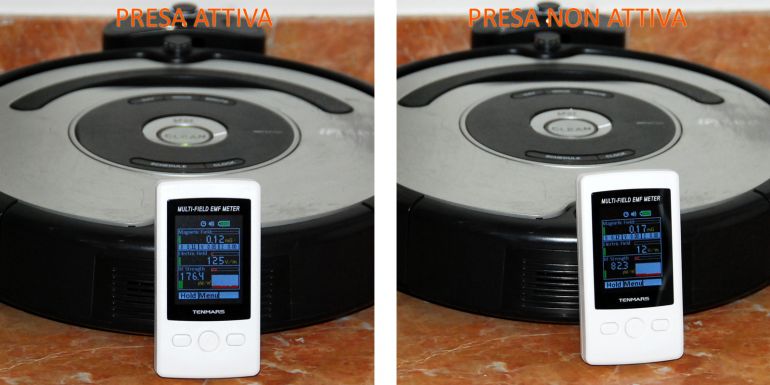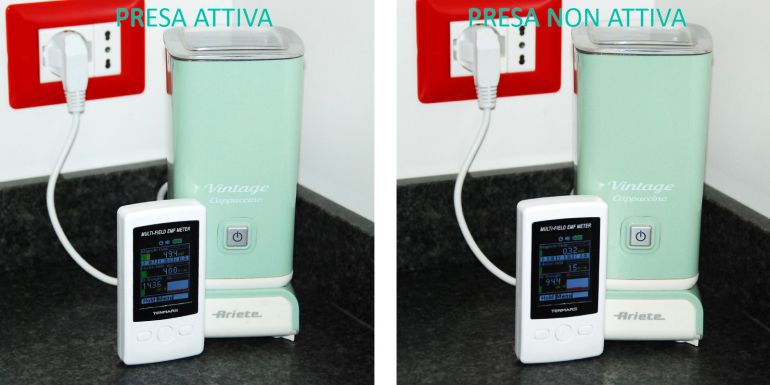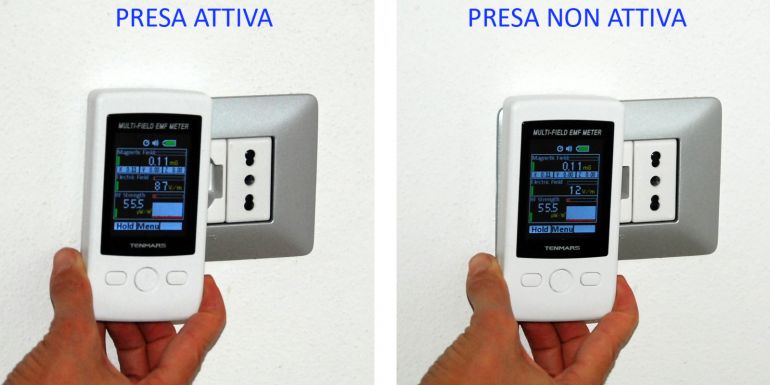In the previous article we started measuring theelectrosmog of household appliances. We carried out two experiments: on a WiFi repeater and on a turned off dishwasher!
We have demonstrated that some household appliances, even if turned off, generate electromagnetic fields. We will demonstrate, in subsequent articles, that switched off appliances also consume electricity.
We have stated with certainty that it is not possible to deny the existence of electrosmog. The electric and magnetic fields that generate it can be measured with appropriate instrumentation (described in the previous article).
Is the Control Casa home automation system really capable of reducing electrosmog from household appliances, both at mains frequency (50Hz) and radio frequency?
Let's see other experiments.
Electrosmog produced by a robot vacuum cleaner
This experiment is also interesting, because it shows that a robot vacuum cleaner emits electromagnetic waves both in low frequency (mains voltage 50Hz) and in RF, just by being connected to a power outlet.
The robot is already charged, so keeping it connected to the electrical outlet is superfluous. In a subsequent article we will demonstrate that these appliances consume energy even if they are turned off, when they are connected to electrical sockets.

The measurements carried out show that, with the robot vacuum cleaner not in use nor even charging (as it is already charged), just because it is connected to a power socket, the value of the electric field is 125 V/m, the RF electromagnetic field value is 176 µW/m2 (the RF field is also present, probably due to the switching power supply inside the robot vacuum cleaner).
By deactivating the socket via the Control Casa home automation system, both values drop: the electric field goes to 12 V/m, while the RF field is reduced to 82 µW/m2. We can see that the reduction of electrosmog is 10 times on the electric field, while 2 times on the RF field.
We ask ourselves the usual question: why allow an appliance to emit electromagnetic waves and consume electricity even if we don't use it?
Let's continue with the experiments and measurements.
Electrosmog produced by a milk frother
With this experiment we reach the peak of energy inefficiency.
The cappuccino maker, or milk frother, is an appliance that is used for a few minutes a day and which, if left connected to the power socket, continues to consume electricity and emit electrosmog for 24 hours a day!
The cappuccino maker is not running, but turned off: it emits electromagnetic waves simply because it is connected to a power socket.

From the measurements carried out we can see that the cappuccino maker also emits a low frequency magnetic field, as well as an electric field and an RF electromagnetic field.
This is certainly caused by the presence of an electromechanical transformer inside, which always remains powered even when the appliance is not in operation.
Here are the measurements. Milk frother off, but power socket active (as in all traditional electrical systems): 49 mG, 400 V/m and 143 µW/m2. The same measurements, carried out with the socket deactivated by the Control Casa home automation system, show a drastic reduction in electrosmog: 0.32 mG, 15 V/m and 94 µW/m2.
The magnetic field has reduced by 153 times, the electric field has reduced by 27 times, while the emission of radio frequency electromagnetic waves has approximately halved.
We could have achieved this same reduction in electromagnetic waves by disconnecting the appliance from the power socket: this operation is convenient for a milk frother, but extremely difficult for an oven or a dishwasher.
The Control Casa home automation system helps reduce electrosmog from household appliances by making the operation of disconnecting the sockets on all the household appliances in the home automatic.
Electrosmog produced by a socket
The last experiment of this article is worthy of attention: a simple socket, without any household appliance connected, emits electromagnetic waves, which causes electrosmog.
If we consider the quantity of sockets present in homes, we can imagine how many sources of electrosmog are present in the domestic environment.

With the Control Casa system, unused sockets are disabled, in order to reduce sources of electrosmog.
Furthermore, the separation of electricity from the socket is not internal to the 503 box which contains the socket, as happens in other home automation systems. With these competitive home automation systems, in which the detachment relay is located near the socket, the electromagnetic waves would even be increased, precisely because of the same system which should instead reduce them.
With Control Casa, not only the socket, but also the meters of cable up to the zone box are no longer carried by current and are no longer sources of electromagnetic waves.
The experiment shows that the value of the electric field goes from 87 V/m to 12 V/m, reducing by more than 7 times.
Conclusion
The Control Casa home automation system is specifically designed to reduce electrosmog from household appliances. It integrates perfectly with the sockets and plates of all manufacturers.
Control Casa is installed during the renovation or construction phase of the home and, as demonstrated by the experiments described above, it is a great ally against the emission of electromagnetic waves, both low frequency and radio frequency.
Control Casa is not just this. Control Casa is: savings, health, completeness, modularity, web app, remote assistance, …
In the next article we will measure the electrosmog produced by a traditional electrical system. We will compare it to the measurements carried out where the Control Casa home automation system is installed. Continue to follow us!